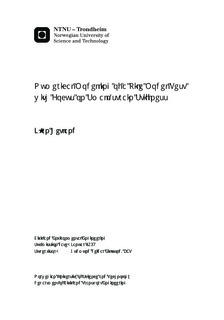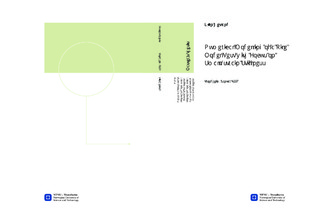| dc.description.abstract | This thesis investigated the dynamic characteristics of a 1:20 scale model of a monopile offshore wind turbine foundation, and performed numerical modelling of the model pile using the FEM-software PLAXIS 3D. The build-up of the laboratory model as well as pile instrumentation was performed in a project work during the spring of 2014.
For the scope of this thesis, the focus was on back-calculations and numerical modelling of the model pile. First, however, the dynamic properties of the model pile was investigated in the laboratory. The first eigenfrequency was investigated using strain gage measurements, and were found to be in the range of 7.7 to 8.8 Hz for different values of overburden pressure, increasing with increased overburden pressure. Using the decay in the strain gage measurements, the damping properties of the Hokksund sand used in the experiments could also be investigated. This was performed using the method of logarithmic decay, and the damping properties were also found to vary with overburden pressure. Damping was observed to decrease with increased overburden pressure.
The eigenfrequency and damping properties of the soil were also found to be time-dependent, or more correctly amplitude-dependent. The eigenfrequency increased with time, and this was believed to be caused by the increased soil stiffness with decreasing strain amplitude. This is a feature of soils investigated by many researchers, and is a feature implemented in the Hardening Soil Small material model in PLAXIS. The damping ratio found by the method of logarithmic decay also varied significantly with time. Decreased damping ratio with time or amplitude was observed from the laboratory tests. Soil damping is caused by friction between grains and irreversible plastic strains. Thus, the decreasing damping ratio observed with time was believed to have been caused by the reduced amplitude reducing the amount of friction and irreversible strains.
Numerical modelling of the problem was performed using the FEM-software PLAXIS 3D. This software is well-known to geotechnical engineers, and its application to problems of this sort is therefore of great interest. An effort was made to model the laboratory conditions in an accurate manner, describing the physical conditions in the laboratory. The model pile was assumed to operate in the small-strain range, and soil stiffness was found by shear wave measurements. In order to reduce computational time, a half model was created. This was found to model the problem in a good manner.
Two different soil models were used. First the problem was solved using linear elastic soil with increasing stiffness with depth. This was found to give a good estimate of the system's first eigenfrequency, overestimating it with a factor of around 1.03. However, the Hardening Soil Small model performed significantly better, overshooting the first eigenfrequency only by a factor of around 1.01.
The series without overburden pressure was found to have a larger error than the other series when comparing the numerical model to laboratory investigations. Structures of this type are believed to operate in the small-strain range, and therefore soil stiffness can be well-estimated using shear wave measurements. However, for the model pile in this case with a relatively low embedded length and relatively low stiffness without the use of overburden pressure, it was believed that larger strains occured, causing the model pile to behave too soft compared to the numerical model with assumptions of small-strain stiffness.
On the basis of these results it can be concluded that PLAXIS 3D is well-suited for numerical modelling of the model pile. It can also be concluded that the stiffness found from shear wave measurements gives a good estimate with regards to the soil stiffness that should be used for such structures. Although mostly influenced by the structural stiffness, the eigenfrequency was found to be significantly influenced by the soil stiffness, and using stiffness found from conventional laboratory testing would in this case significantly underestimate the first eigenfrequency. | |

